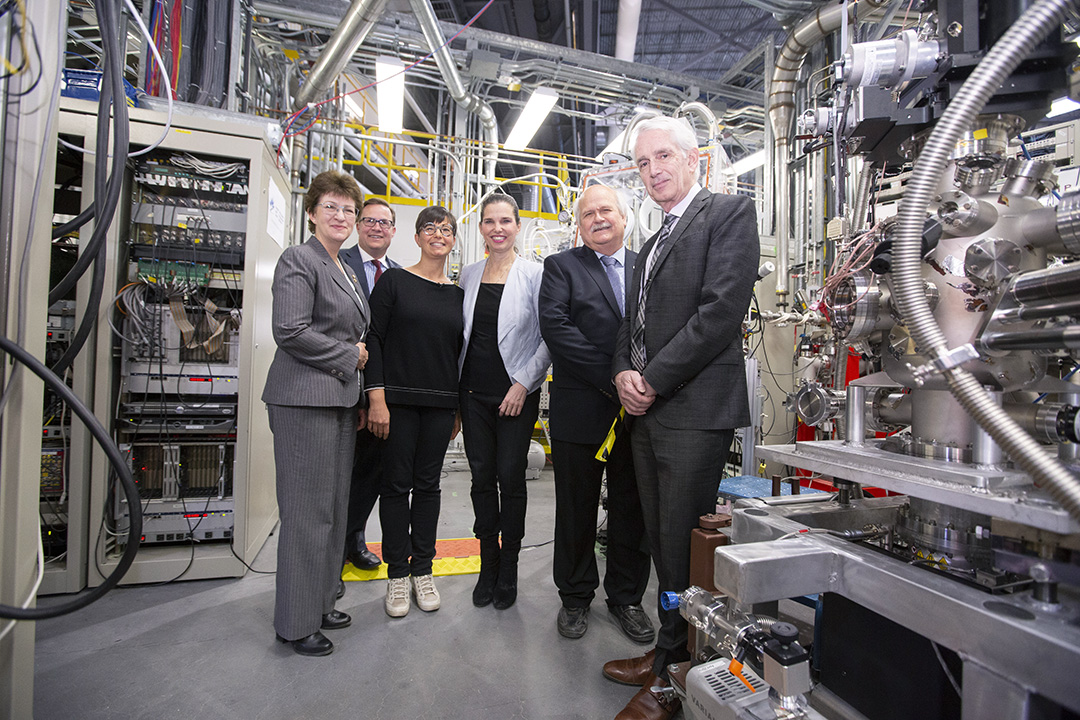Today’s announcement at the university by Canada’s Minister of Science and Sport Kirsty Duncan aims to support cutting-edge collaborative international research at seven major Canadian research facilities. The other five are: Ocean Networks Canada, SNOLAB, CCGS Amundsen, Ocean Tracking Network, and Canada’s National Design Network.
“This significant increase in federal funding for the largest of Canada’s scientific facilities is crucial to Canada’s success as a global leader in innovation and discovery,” said Peter Stoicheff, president of the University of Saskatchewan.
“With two of the seven facilities, the University of Saskatchewan is well supported in its ambitions to be the university the world needs through cutting-edge research that improves human and animal health, agriculture, and the environment.”
The $39-million federal investment involves a revised funding formula intended to help ensure the long-term sustainability of these nationally important research facilities, by alleviating budget pressures related to challenges in securing partner funding contributions. The increase is part of an additional $160 million committed in the 2018 federal budget for the CFI’s Major Science Initiatives Fund.
“This funding decision recognizes that the Canadian Light Source (CLS)—in partnership with our industrial and academic users across the country and around the world—is undertaking vital, groundbreaking discoveries in basic and applied science that are contributing to the health and prosperity of Canadians,” said CLS Executive Director Rob Lamb.
The revised funding formula will mean an additional $11.56 million for the CLS for fiscal years 2018-19 and 2019-20. This will enable the CLS to hire about 30 more staff (for a potential total of about 245), mainly to provide higher levels of customer service for beamline users, and enable the machine group to undertake vital maintenance and facility upgrades, specifically on components of the core machine.
For VIDO-InterVac (Vaccine and Infectious Disease Organization-International Vaccine Centre), the CFI funding decision means an additional $1.86 million for fiscal years 2018-19 and 2019-2020.
“We are very grateful for this funding which is vital to enable Canadians to maintain a competitive advantage in infectious disease research and to help safeguard human and animal health through innovative vaccine technology,” said VIDO-InterVac Director Volker Gerdts.
He said the funds will be used to rapidly complete key maintenance and upgrades, and reduce the costs for research, thereby attracting more scientists to conduct much-needed research on infectious diseases. The additional funding will also help the centre expand the list of emerging diseases it investigates, enabling it to better serve Canada in times of national emergencies.
The announcement was welcomed by Nazanin Samadi, a USask physics and engineering physics PhD student working at the CLS, Canada’s only synchrotron.
“It’s this kind of investment that I hope one day will lead someone, a student like me perhaps, to make significant discoveries in the scientific areas in which the CLS specializes—health, agriculture, environment and advanced materials—that could have a significant impact on the lives of Canadians,” she said.
Samadi’s research aims to improve synchrotron-based imaging techniques for medical research.
“This research will not only improve the quality of the beam available for research on the biomedical beamline, but also on all 22 beamlines at the CLS, and potentially all synchrotrons around the world,” she said.
“We’ve been collaborating on this research with other light sources in Japan, Italy, France and Switzerland on applying new imaging tools, and very actively with the United States to further develop my diagnostic method for assessing the performance of their machines.”
Kylee Drever, a USask master’s student, is part of a team at VIDO-InterVac working to come up with a new vaccine for tuberculosis (TB), a disease that kills more than one million people every year and infects 10 million people globally each year. New effective treatments are desperately needed.
“VIDO-InterVac is one of only a few labs that can study certain infectious diseases including TB, a disease that can be transmitted between humans and animals,” she said.
Her research focuses on how the TB bacterium is able to establish successful infections.
“Even though we as humans have been aware of tuberculosis as a disease for millennia, we are nearly in the dark when it comes to the details of how it interacts with and affects our bodies,” she said. “It is imperative to understand the host-pathogen relationship to effectively direct research towards effective TB treatments.”
She said the university’s infectious disease research infrastructure is among the best in the world.
“As a prospective TB researcher, it is wonderful to be part of the research at VIDO-InterVac that is benefiting Canada, especially our northern communities, and the rest of the world.”
More information is available at: www.innovation.ca, www.lightsource.ca and www.vido.org
Article re-posted on .
View original article.
